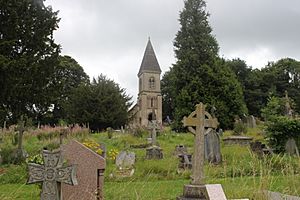Bath Abbey Cemetery facts for kids
The Bath Abbey Cemetery is a special old graveyard in Bath, England. It's officially called the Cemetery of St Peter and St Paul, named after the saints of Bath Abbey. A famous garden designer named John Claudius Loudon planned this cemetery between 1843 and 1844. It sits on a pretty hillside with great views over Bath.
It was opened on January 30, 1844. A person named W. J. Broderick, who was the Rector of Bath Abbey, paid for this private cemetery. It has a mix of formal and informal garden styles, with a main path running through it. There's also a special building called a mortuary chapel, designed by Bath City Architect G. P. Manners. It was built in a style that looked like old Norman buildings.
Contents
A Look Back: History of the Cemetery
This cemetery is built on a very old site! Long ago, the Romans used this area for burials. When the road to the chapel was being built, workers found three stone coffins and old Roman coins. In 1952, another Roman coffin was found while removing a tree root.
A very unusual writer named William Thomas Beckford was first buried here. Later, his body was moved to another cemetery.
The cemetery and its mortuary chapel are very important historical sites. They are listed as Grade II* buildings. This means they are especially important and protected. Many of the monuments inside the cemetery are also listed as Grade II or II* buildings. You can often tell how important a person was by how fancy their monument is. People who lived in the fanciest houses often had the most detailed memorials.
Interestingly, monuments for church leaders often have a Gothic style, which looks like old churches. Monuments for military people often have a Greek style, which looks like old Greek temples.
Right next to Bath Abbey Cemetery is another graveyard called Perrymead Cemetery, which is for Roman Catholic burials.
The Mortuary Chapel: A Special Building
The mortuary chapel was built in 1844. It was designed by George Phillips Manners in the Norman Revival style. This style makes it look like buildings from the Norman period (around 1066 in England). The chapel has a tall tower and a covered entrance.
The chapel was built above a crypt, which is an underground room often used for burials. It was planned to have open wings on the sides with places for ashes or coffins.
Since the cemetery closed, the chapel has also been closed. It is slowly falling apart. It was first listed as a historic building in 1975 and is now a Grade II* listed building. Bath Abbey still owns it.
Famous People and Memorials
The cemetery has many interesting memorials for people who lived in Bath. Here are a few notable ones:
- Crimean War Memorial: This is a tall, pointed stone monument from around 1855. It honors those who fought in the Crimean War.
- Joseph Chaning Pearce: He was a collector of over 200 fossils! His memorial is made of polished pink granite.
- James Weeks Williams: His memorial is a beautiful white marble mini-temple. It has four columns supporting a canopy over an urn. One side of the monument remembers his 17-year-old son, Henry, who sadly drowned in London in 1853.
- Ann Partis: She was the founder of Partis College. Her white marble memorial is also a listed building.
- Rear Admiral John Bythesea: He was a hero from the Crimean War and received the Victoria Cross, which is a very brave award. He died in 1906, and his grave has a tall Celtic granite cross.
- Arnold Ridley: He was a famous actor and also received an OBE award.
War Graves
This cemetery is also the resting place for three soldiers who died serving their country in World War I. Their graves are cared for by the Commonwealth War Graves Commission. These include a British Army Captain, a Canadian soldier, and a Royal Air Force airman.


